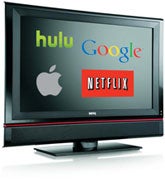On September 1, Apple CEO Steve Jobs launched the latest version of what he previously referred to as “a hobby”: Apple TV — a hockey puck-sized set-top device that allows viewers to rent movies and TV shows. Meanwhile, Google plans to embed its services on televisions from Sony. And Samsung is developing its own apps for its TVs and trying to woo software developers. These efforts are all part of the latest attempt to conquer the digital living room, an area that, so far, has failed to make couch potatoes think differently about their viewing habits.
The digital living room as a concept has been around for years. The vision: Television will be connected to the Internet, and viewers — who are generally passive consumers of content — will become more interactive participants. Through their televisions, viewers will start microblogging via Twitter, updating Facebook with comments about the shows they watch and sharing YouTube videos with friends. Meanwhile, they will access whatever programming they want, whenever and however they want.
The problem, according to Wharton faculty and other experts, is that consumers are not likely to change their television habits very quickly. Indeed, during the September launch event, Jobs acknowledged that Apple TV has “never been a huge hit” in the four years it has been on the market. Apple’s competitors haven’t been successful in this arena, either, he noted. Apple believes people want to view Hollywood movies and shows on their own schedule. “They don’t want amateur hour. They want professional content,” said Jobs. But so far, consumers have not shown a clear interest in having a computer on their TV. “It’s a hard one for people in the computer industry to understand,” Jobs added.
Going against that grain, Google has set out plans to embed its Android operating system, which is popular in smartphones, on TVs and set-top boxes. Speaking at a recent technology conference, Google CEO Eric Schmidt said that the search giant will change viewing behavior. “Once you have Google television, you’re going to be very busy,” said Schmidt, according to an article on Wired.com. “It’s going to ruin your evening.” At Google’s developer conference in May, executives highlighted Google TV, which promises “a new experience made for television” that uses the Internet to complement the viewing experience. The concept is that Google will seamlessly integrate the TV, DVR and Internet as well as feature a web browser and search capabilities. Sony, Logitech, Intel and DISH Network are initial partners.
In addition, Sony has recently demonstrated TVs that feature Google software and services. Samsung is reportedly evaluating Google TV. A bevy of other players ranging from Roku, which provides a set-top box for Netflix and Amazon.com on-demand movies, and Boxee, which streams Internet content on televisions, to Microsoft, Netflix and Amazon all have plans to deliver digital content to the living room. And entrenched entertainment companies such as Comcast, Cablevision, Time Warner cable and consumer electronics makers are not standing still.
Theory vs. Reality
The theory behind these moves is that consumers will be dragged into the interactive TV age whether they want to go or not. Or will they?
Peter Fader, a marketing professor at Wharton, says all the competition in the digital living room is refreshing, but it is unclear whether there will be a payoff. “The digital living room is a lot like Afghanistan. Some superpower tries to take it over and set it straight, but the people don’t want to be taken over,” says Fader. “It’s a very slow evolution to the digital living room.”
Wharton marketing professor Eric Bradlow points out that there is a lot of consumer inertia in home entertainment. TV Everywhere, a service which brings cable television content from companies like Comcast, Time Warner Cable and others to multiple screens including laptops and smartphones, keeps consumers from switching to new players. If any new entrant upends incumbent companies in providing content to the living room, it will take place “at a very slow rate,” he says.
Even so, the race for the digital living room is a crowded field. Apple, Netflix, Google, Amazon, Microsoft and cable companies as well as consumer electronics companies are all vying to blend home entertainment, technology and interactivity. Companies such as Cisco, best known as a networking company, can also be found in the living room via set-top boxes, routers and devices like the Flip camera, a small video recorder that makes it easy to upload content to YouTube and a computer.
“This battle is not zero sum,” notes Andrea Matwyshyn, a legal studies and business ethics professor at Wharton. “There’s so much room for innovation here, and it’s not clear who the winner will be in the long term.” She argues that it is fruitless to crown any of these rivals as a future king of the digital living room. “How people will use these tools is [as yet] undetermined. When devices are introduced to the living room, there may be unintended uses.”
The challenge for companies looking to conquer the digital living room is finding a business model that works. Models will vary, but experts at Wharton generally agree that content subscriptions will play a key role. Indeed, Netflix has a subscription DVD rental business, but is increasingly delivering streaming movies as part of a subscription. To connect to consumers’ living rooms, Netflix has embedded its service on multiple devices ranging from TVs to game machines like the Xbox and Blu-ray players from various manufacturers.
“A monthly subscription gives people the feeling that they can consume as much as they want out of a large catalog,” says Kartik Hosanagar, an operations and information management professor at Wharton. “Netflix has set the standard as far as consumer expectations go, and I don’t see the Netflix-like subscription model going away anytime soon, at least for video content.”
Apple plans to sell its device for $99 and then rent movies and TV shows through its iTunes store. Google is embedding interactive features on TVs and is likely to collect ad revenue, analysts predict. Hulu, a video joint venture between major TV networks, is adding a premium subscription option to its free, ad-based service. Other companies, like Microsoft, will license technology to cable and telecom providers to integrate entertainment with the PC.
“Given how different the business models are, it’s possible that these companies will segment the market by focusing on different niches,” such as premium movies versus on-demand broadcast television, says Kendall Whitehouse, director of new media at Wharton. One thing is certain: The experimentation will continue. “It will be a long time before any one of these services gives people a compelling reason to pick one brand over another,” says Fader. “We haven’t seen one thing yet that [makes one say], ‘Wow, this is the Holy Grail.'”
Another possibility is that these companies looking to conquer the digital living room may just be making incumbent companies like Comcast, Sony and Samsung move more aggressively into this arena. Efforts like TV Everywhere are partially designed to give consumers access to content on multiple screens and fend off newcomers such as Google’s YouTube and Apple, Fader notes.
Good Content, Quickly
The winners in the digital living room are likely to be determined by distribution and content. If companies like Apple and Google can bring content like movies quickly while adding new features, they can be contenders, Wharton experts say. They add that if these new entrants cannot bring a wide range of content to the masses, the cable companies — which are experienced with packaging entertainment and negotiating with Hollywood over costs — are likely to stay entrenched.
Indeed, Apple partnered with Netflix to offer streaming video on Apple TV, and it plans to offer movies for rent the same day they are released on DVD. Google’s YouTube is reportedly negotiating with Hollywood to also rent movies. As YouTube becomes embedded on Internet connected televisions, Google may have a viable movie rental service, analysts note.
Thus far, Netflix has an early lead in the race by shunning hardware and forging partnerships to be included with televisions, Blu-ray and DVD players, and other devices. The aim is to be on any set-top box that could be in the home entertainment center. Fader applauds Netflix’s approach. “In the end, hardware may not matter. The consumer may have no clue what hardware he is using. The set-top box may ultimately disappear, and the tie breaker will be the content.”
Last month, Epix, a venture that features the libraries of Paramount, Lionsgate and MGM, forged a multi-year agreement with Netflix to distribute movies. However, Netflix will get the movies 90 days after premium pay-TV and subscription on-demand debuts. “The action is in the distribution,” says Bradlow. “The best distribution will win.”
According to Whitehouse, so-called content “release windows” will become critical to companies like Netflix, Apple and Google. He notes that consumers may rent a movie for $4.99 from Apple if it means they can get it right away — even if they have a Netflix subscription that would provide the same material weeks later. In the digital living room, just offering a movie a few days earlier than a rival may make a big difference. Fader agrees. “The big issue is the release window,” he says. “If a company can offer a movie just a little earlier than others, it can get traction. It’s all about timing more than the technology or the business model.”
Some experts at Wharton note that the digital living room may be the one place where content is king, compared withthe web, where distribution from the likes of Google matters more. The challenge will be finding the right blend of professional and amateur content to delight the consumer. “People want both free, self-produced content — like you find on YouTube — and professional [Hollywood productions],” says Whitehouse. The company that can combine both sets of content into a single, streamlined interface will be the one that will win out, he predicts. “Relationships with the film industry are going to be key to making this happen — that’s the difficult part of the equation.”
Whitehouse also suggests that the movie studios should explore hybrid pricing and distribution models. “If a consumer rents a movie for $5 to view it the first day it’s available, why not offer them the same amount off a DVD purchase?” he asks. This would make it less onerous for the consumer to purchase both — and make it easier for the studio collect money at multiple points in the release window.
A Google-Apple Showdown?
While it’s unclear how the latest chapter of the digital living room competition will play out, experts at Wharton say it could turn out to be yet another showdown between Google and Apple.
Analysts predict that Apple TV’s price drop (from $229 to $99) may make it more of a hit with consumers. However, Piper Jaffray analyst Gene Munster said in a research note that Apple TV may just be a precursor to something bigger. “The pricing of Apple TV falling … is a step in the right direction and, we believe, confirms Apple’s greater interest in the living room,” he wrote. Last month, Munster speculated that Apple could ultimately manufacture its own Internet connected HDTV in the next two to four years with a full complement of content, integration with iTunes and connections to its other devices such as the iPhone, iPod, Mac and iPad. In other words, Apple TV is “a stepping stone toward an all-in-one connected television,” Munster said.
A move to make an Apple HDTV would be one way to elude the so-called set-top box conundrum. Jobs has said that consumers don’t want to buy another set-top box; the primary set-top boxes are subsidized by cable companies, so the consumer has little interest in buying additional ones. Munster argued that Apple could sell an “iTunes TV Pass” that could replace a consumer’s monthly cable bill. Live television, however, would be a hurdle.
Hosanagar notes that Apple’s strategy has been “to control the whole ecosystem, including the end device, so Apple could do the same with a TV.” He adds that Apple could “differentiate itself through the user interface, apps and functionality.” According to Fader, a move into the cutthroat TV manufacturing market would be fraught with risk, however. “Samsung could develop the exact same TV Apple would,” he says. Whitehouse agrees, adding that despite Apple’s usual tack of bundling their own hardware and software, in this case the company may be better off “licensing its software to companies like Sony and Samsung” than directly competing in the television market.
Meanwhile, Bradlow downplays the importance of Apple making an HDTV. “I think people are progressing downward in terms of screen size,” he says. “The lure of the big TV is still there, but people are getting used to high-def iPad-size screens.”
Google’s approach is dramatically different than Apple’s. Google is looking to leverage its Android mobile operating system, provide access to applications and use search as a primary vehicle to find entertainment anywhere — ranging from cable providers to Netflix to the Internet and sites like NBA.com and YouTube. In mid-September, Google-owned YouTube conducted a two-day experiment to test live streaming content.
“I’d say that Google TV so far has better positioning than Apple TV,” says Hosanagar. “Google’s willingness to work with TV manufacturers and its partnerships with incumbents like DISH Network will hopefully allow tighter integration.”
According to Matwyshyn, Google could fill a key void in the digital living room. “What’s missing is not necessarily the integration of readily available content, but being able to provide a user experience that leverages the wealth of freely available content in one place.” The key will be enabling consumers to find content when they want and in any incarnation. “That’s the future — finding content from any source that exists.” The challenge for media companies and cable firms is that they will relinquish some control to enable this search capability, she adds.
While searching for content on a television sounds appealing, it’s unclear whether consumers will alter their behavior from traditional channel surfing. “The question with all of this revolves around how consumers construct mental models,” Matwyshyn notes. “For a lot of people, the computer — whether it’s on TV or a laptop — represents work; TV is a toy that equals relaxation. The digital living room’s balancing act is between functional and fun. The line between work and relaxation won’t be the same for every consumer.”
Given that fact, some experimentation is warranted. “Let’s put the tools out there and let the consumer experiment at [his or her] own pace,” says Matwyshyn.



